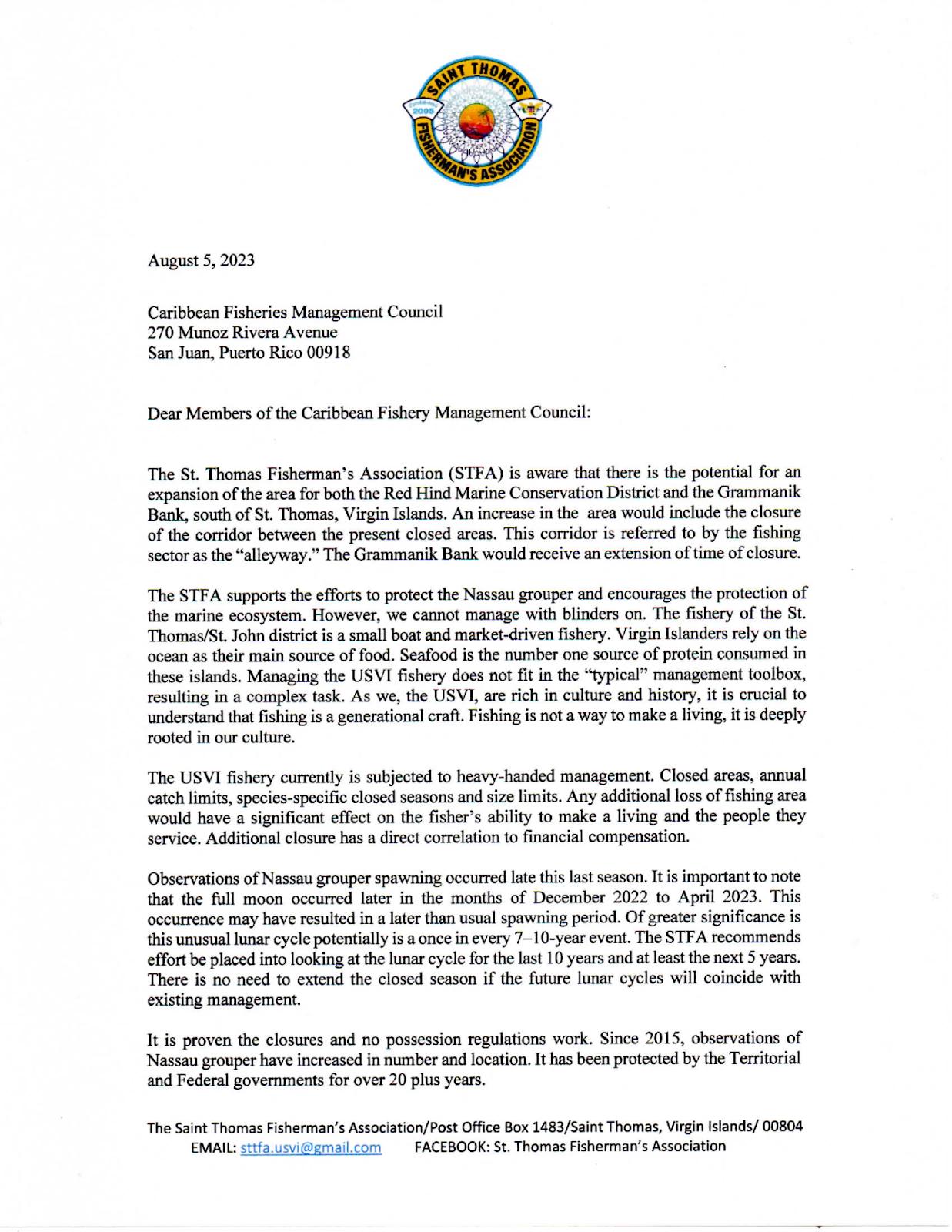Response to Questions from the St. Thomas Fisherman’s Association Regarding Management of the Hind Bank Marine Conservation District and Grammanik Bank


Draft White Paper April 2025


Response to Questions from the St. Thomas Fisherman’s Association Regarding Management of the Hind Bank Marine Conservation District and Grammanik Bank


Draft White Paper April 2025

Objective: Develop a white paper to address the points made in the letter presented by the St. Thomas Fisherman’s Association (see Appendix A) at the August 2023 Caribbean Fishery Management Council (Council) meeting, which was in response to the recommendations by Nemeth et al. (2023) for extending the seasonal closure of Grammanik Bank.

What was the total landings recorded from the area referred to as the alleyway?
For the purpose of this analysis, the location known as the alleyway is the area connecting the Hind Bank Marine Conservation District (MCD) and Grammanik Bank (Figure 1).

Figure 1. Location of the Hind Bank MCD and Grammanik Bank managed areas south of St. Thomas, U.S. Virgin Islands (USVI) and the area known as the alleyway that connects them, as described in this document.
Prior to July 2011, the St. Thomas and St. John, USVI commercial catch report included boxes for commercial fishermen to report the area(s) fished specific to gear types. For St. Thomas/St. John, the fished area included four zones: TNW, TNE, TSE, and TSW (Figure 2). The Hind Bank MCD, the alleyway area, and most of Grammanik Bank are located in TSW. The northeast portion of Grammanik Bank is in zone TSE. Beginning in July 2011, a 2.5 x 2.5 mile grid system replaced the four fishing zones for commercial fishermen to report landings (Figure 3).
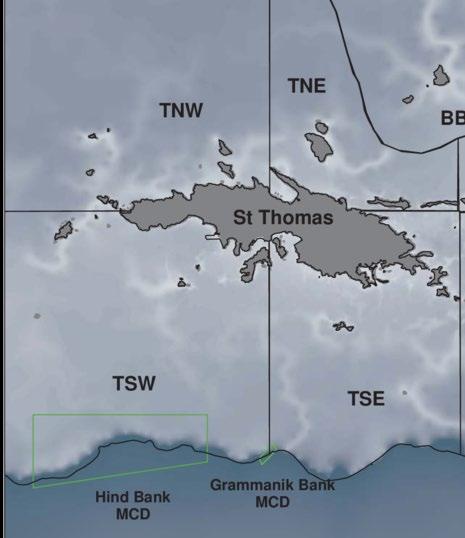
Figure 2. Fishing zones used in commercial catch report forms from 2000 through July 2011.
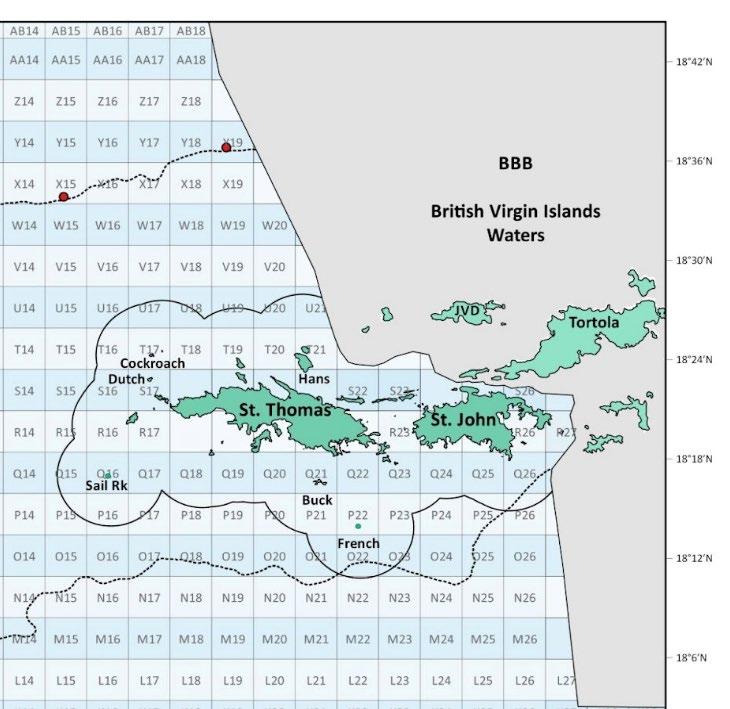
Figure 3. Grid of fishing zones used in commercial catch report forms since July 2011.
For this analysis, commercial landings information from 2014-2022 were analyzed for the alleyway area, which was estimated to be in grid cells O19-O20 (Figure 4). Landings from fishing years 2012, 2013, and 2023 were available at the time this report was prepared, but are confidential and therefore not included in the analysis. The National Marine Fisheries Service (NMFS) is working with regional partners to develop a GIS shapefile that includes the USVI catch report grid cells and the Hind Bank MCD and Grammanik Bank area boundaries, and notes that a portion of the alleyway area analyzed in this document could include a portion of the Grammanik Bank, which is closed year-round to trap gear and seasonally for the harvest of select grouper species (i.e., red, black, tiger, yellowfin, and yellowedge groupers).
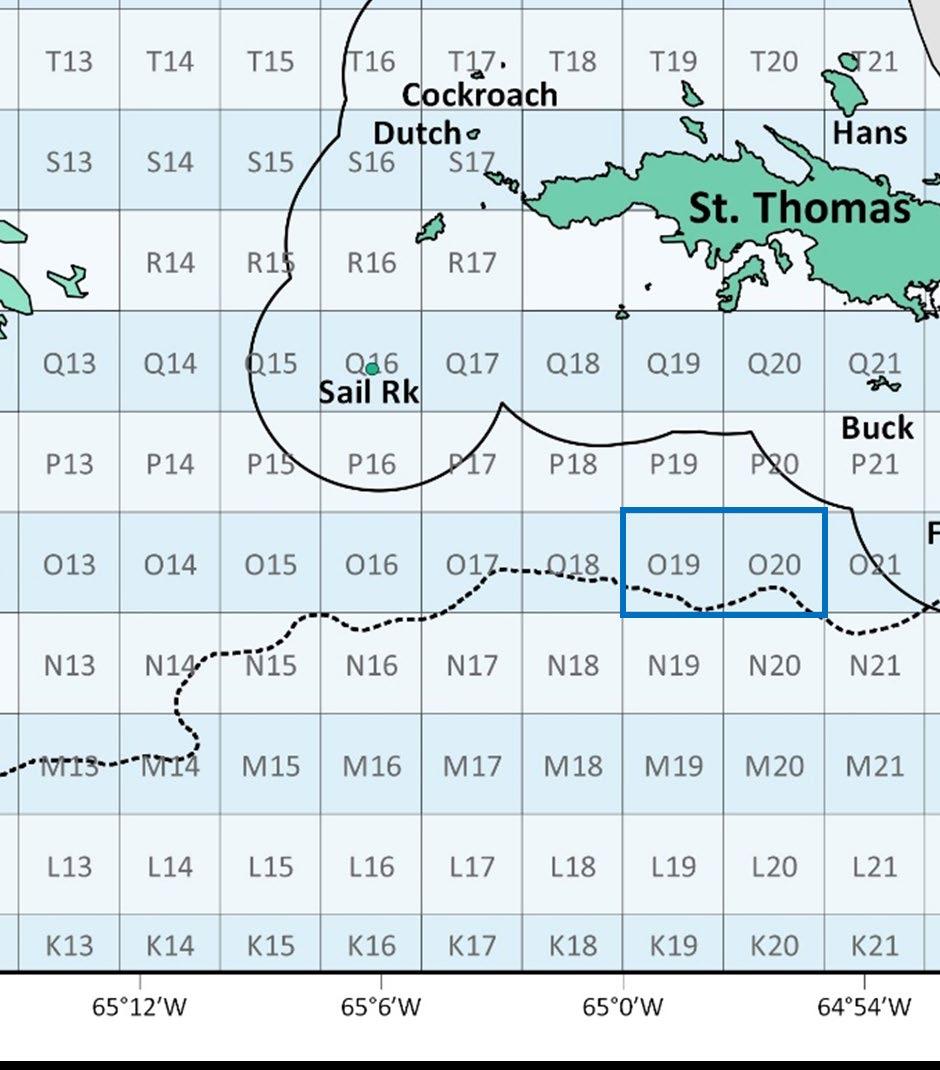
Figure 4. Location of fishing zone grid cells (blue rectangle) estimated to represent the alleyway area between the Hind Bank MCD and Grammanik Bank.
For the 2014-2022 period, of the 3,226,194 total pounds (lbs) reported by commercial fishermen in St. Thomas/St. John, 92,913 lbs (2.9%) were reported from the alleyway area (Table 1).
During that period, 84,309 lbs of the 92,913 lbs (90.7%) were reported with trap gear. The average number of fishing areas (i.e., the 2.5 square mile grid cells and 4 fishing zones) where landings were reported each year during the 2014-2022 period was 144.
For 2014-2022, a substantial portion of the 92,913 lbs reported in the alleyway area were recorded in January (18.7%), February (13.0%), and March (11.3%). The top species reported in the alleyway area during this time included queen triggerfish (20.7%), red hind (15.9%), spiny lobster (12.9%), yellowtail snapper (8.2%), white grunt (4.0%), and gray angelfish (3.9%).
Of the 84,309 lbs reported in the alleyway area with fish trap gear, approximately 2% were the seasonal groupers (i.e., red, black, tiger, yellowfin, and yellowedge grouper).
Table 1. Total annual landings reported and number of St. Thomas/St. John commercial fishermen from all areas combined/all gear types combined, the alleyway area (cells O19 and O20)/all gear types combined, and the alleyway area/trap gear only for 2014-2022.
Source: SEFSC Reporting System accessed on January 16, 2025.

For the 2014-2022 period, the range of commercial fishermen who reported landings from the alleyway area ranged from 5 to 9, with an average of 7 fishermen per year (Table 1). During that period, the number of commercial fishermen using trap gear in the alleyway area ranged from 3 to 5, with an average around 4 fishermen per year.

many traps were recorded in the alleyway area and at what month of the year?
A fish trap reduction program for USVI commercial fishermen became effective on August 21, 2017. Under the program, the maximum number of fish traps that each commercial fisherman in the St. Thomas/St. John district may possess is 250. Shortly after this program was implemented, Hurricane Irma passed directly over St. John and St. Thomas as a category 5 storm
and many of the commercial trap gear were lost or damaged. Thus, for this document, the analysis included information from years 2019-2022.
The total number of fish traps deployed in the alleyway area each month for the 4-year period ranged between 0 and 685, with a larger number of traps deployed in January through March (average of 417 traps). Commercial fishermen place traps in the alleyway area when groupers are spawning (December - March) because other fish that they target (e.g., queen triggerfish) move into the area to eat the grouper eggs (J. Magras, St. Thomas/St. John DAP Chair, pers. comm.). During the 4-year period, fish traps were present in the alleyway area every month from January through June. In the second half of the year (July through December), the number of fish traps present in the alleyway area was less consistent, with zero traps reported in 11 of the 24 months during the four years. The number of traps deployed in an area varies depending on the availability of the desired species of fish during the year (J. Magras, St. Thomas/St. John DAP Chair, pers. comm.).

What data is there to substantiate that the Nassau grouper solely travels to and from the closed areas during the spawning season via the alleyway area?
Over the 2014-2022 period, a small amount of Nassau grouper were reported as catch and discarded. However, none of these incidental catches were recorded in the alleyway area (i.e., grid cells O19 and O20).
Landings of grouper species that are subject to the February 1 to April 30 seasonal closure each year (i.e., red, black, tiger, yellowfin, and yellowedge groupers) reported in the alleyway area between 2014 and 2022 with fish trap gear were approximately 1,000 lbs, nearly all of which (97%) were reported during the open season. As shown in Table 1, the total amount of commercial landings reported in 2014-2022 in the alleyway area using trap gear was 84,309 lbs. Thus, the seasonal groupers comprise a small percentage of the species caught in this area with this gear type.
At the 169th Council meeting in June 2020, staff from the University of the Virgin Islands (UVI) presented research results on the abundance of Nassau grouper observed at the Grammanik Bank site over a 17-year period (Kadison 2020 pgs. 246-274). During dive surveys, the number of Nassau grouper per dive increased from less than 40 in 2004 to over 500 per dive in 2020, a steady increase over the 17-year period that highlights the effectiveness of management measures and fisher compliance with those measures. The presentation included a map with acoustic receiver locations and movements of tagged Nassau groupers. The tagged Nassau groupers spent most of the time inside Grammanik Bank, but in between spawning events and during the day, would occasionally migrate towards the Hind Bank MCD four kilometers away,
using a corridor along the southern edge to go back and forth between the two management areas. Additionally, at the 183rd Council meeting in December 2023, Dr. Nemeth from the UVI presented on the status of Nassau grouper in the USVI, highlighting results from the USVI’s Territorial Coral Reef Monitoring Program and the Nemeth et al. (2023) telemetry study.
Acoustic tagging studies have shown connectivity between the Grammanik Bank and Hind Bank MCD (Rowell et al. 2015; Nemeth et al. 2009 and 2023). Nemeth et al. (2009) reported that Nassau (Epinephelus striatus) and yellowfin (Mycteroperca venenosa) groupers used two of three 50-meter parallel reefs that run east-west between Grammanik Bank and the Hind Bank MCD. The yellowfin grouper mostly used the reef farthest from the shelf edge (~ 1 kilometer), while the Nassau grouper used the reef that was approximately 300 - 500 meters north of the shelf edge. The reef running along the shelf edge was not used by any tagged fish. Nassau and yellowfin groupers spent an average of 75% and 44% of their time, respectively, within the Grammanik Bank closure.
Rowell et al. (2015) found that from 2007 to 2012, 64% of Nassau grouper and 76.2% of yellowfin grouper migrated from the Grammanik Bank spawning aggregation site to the Hind Bank MCD (Figure 5). The Nemeth et al. (2023) study further highlights the pathways between the Nassau grouper spawning aggregation site in Grammanik Bank and an area near the historic Nassau grouper spawning site in the Hind Bank MCD during the spawning season (Figure 6). The pathways indicate a wide use of areas outside of the spawning aggregation site (i.e., the blue circle). Several of these pathways can be observed in the alleyway area between Grammanik Bank and the Hind Bank MCD. Nemeth et al. (2023) calculated that Nassau grouper were located in Grammanik Bank about 65% of the time during the spawning season. The remaining time, the fish were actively migrating to and from the spawning site, staging areas, and temporary resident sites.
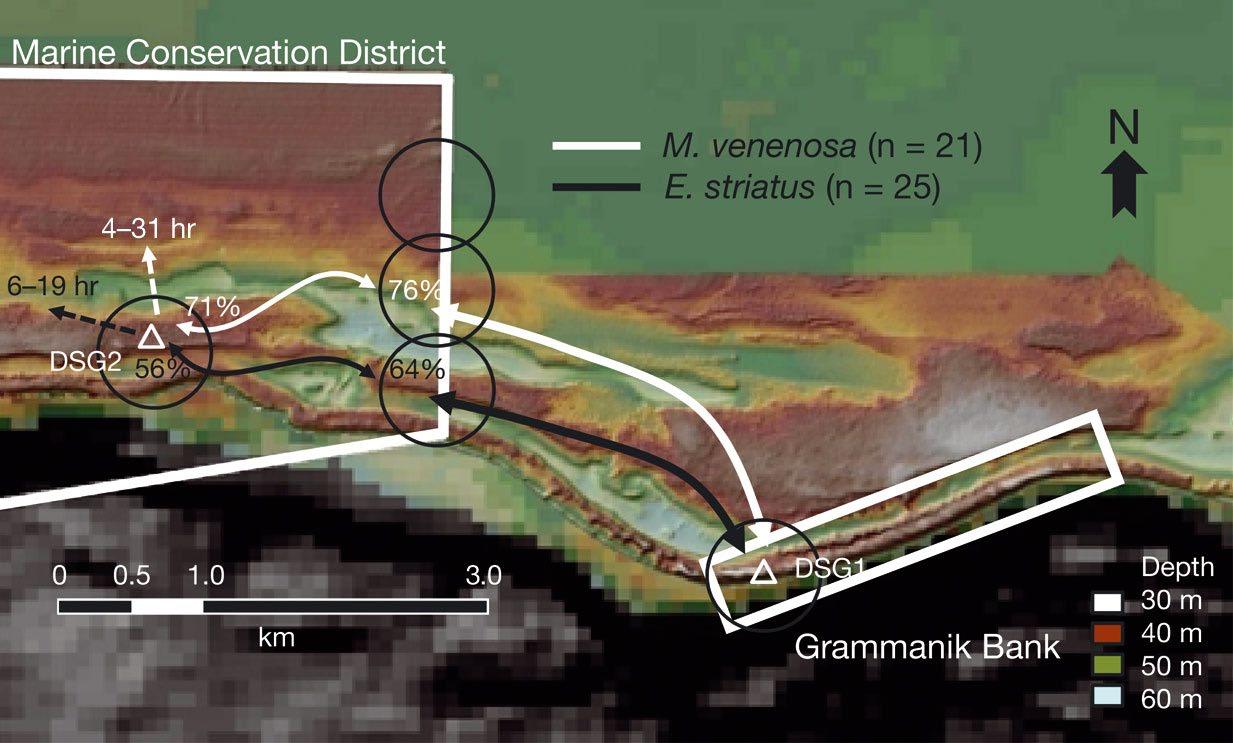
Figure 5. Figure 5 included in Rowell et al. 2015 illustrates the migration pathways of yellowfin grouper (white arrow line) and Nassau grouper (black arrow line) between the Grammanik Bank spawning site and the eastern boundary of the Hind Bank MCD. The black circles represent the location of acoustic telemetry receivers and the white triangles represent the location of passive acoustic recorders, with the percentage of tagged yellowfin and Nassau grouper that were detected near the receivers.
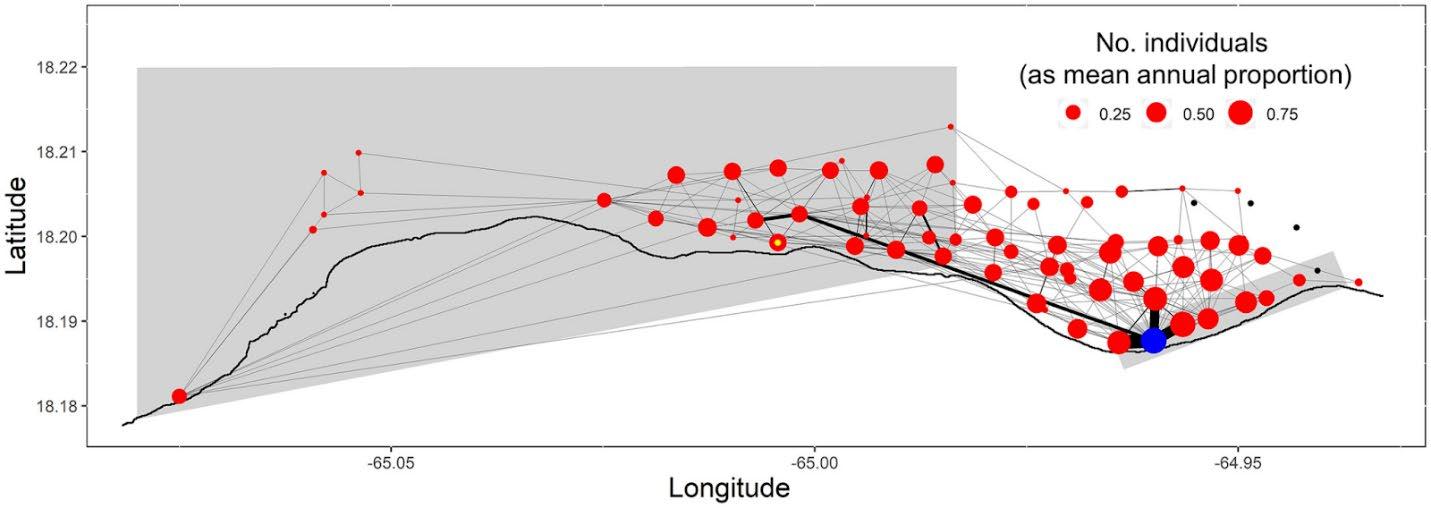
Figure 6 Figure 7 included in Nemeth et al. 2023 illustrates the spatial network of Nassau grouper movements during the spawning season. Circles in the figure represent the receiver locations (red), the Grammanik Bank spawning site (blue), the historic spawning site in the Hind Bank MCD (yellow), and stations with no detections (black). The thickness of pathways between receivers corresponds to the relative number of movements between these locations and the size of the circles corresponds to the number of individuals detected at each station.

Recommendation to increase funding for outreach and supplies focusing on increasing the survival rates of incidental capture. This would include instructions on “how to deflate a swim bladder.”
From Dr. Nemeth’s presentation at the December 2023 Council meeting:
Outreach campaigns were done in 2006 to 2010 when Grammanik Bank was first established and large numbers of juvenile Nassau showed up around St. Thomas and St. John. This included posters and flyers at public outreach events.
Distribution of fisher science kits that included:
• Notebook
• Pencil
• Tape measure
• Large bore hypodermic needle for venting fish air bladder
• Barbless hook and weight for sending fish to bottom to recompress air bladder
The presentation also included a summary of the outreach campaign fliers that were used in promoting conservation of Nassau grouper.
In the USVI, commercial trap fishermen have little bycatch, meaning almost everything that is caught is kept. Some exceptions would include prohibited species, undersized individuals managed with a minimum size limit, oversized individuals not marketable, or out of season fish. Most commercial trap fishermen in St. Thomas/St. John use venting tools when necessary, for instance when the fish is showing signs of barotrauma (J. Magras, St. Thomas/St. John DAP Chair, pers. comm.). Currently, the bycatch information included on the USVI commercial report forms does not include the disposition of the discarded fish (i.e., released alive or dead).
NMFS and the Council have proposed requiring a descending device be on board a commercial or recreational vessel and readily available for use while fishing for or possessing species in the reef fish component of the Puerto Rico, St. Croix, and St. Thomas and St. John FMPs (see Amendment 2). Rulemaking to implement this requirement began in 2024, and is expected to become effective sometime in either late 2025 or early 2026. The January 2025 issue of the Caribbean Fishery Management Council newsletter (read in English, Spanish) includes a description of the new descending device requirement and helpful information for fishermen including photos and links to help fishermen build or acquire a device.

Have there been any new spawning aggregations discovered inside or outside of the existing closed areas? If yes, have they been studied?
As mentioned in Dr. Nemeth’s December 2023 presentation, no new spawning sites for Nassau grouper have been found. Researchers have not seen more than a dozen Nassau grouper during the spawning season at the historic Nassau grouper spawning site (i.e., Hind Bank MCD). There is anecdotal information of an active Nassau spawning aggregation on the drop north of St. Thomas, which would need to be evaluated.
Researchers with the UVI have discovered additional spawning aggregation sites for other species within the Hind Bank MCD and Grammanik Bank (R. Nemeth, UVI Research Professor, pers. comm.), some of which are included in published studies. These include sites for mutton snapper, dog snapper, and cubera snapper (Biggs and Nemeth 2016), tiger grouper, red hind (Chérubin et al. 2020), hogfish, and Bermuda chub (Nemeth and Kadison 2013) in Grammanik Bank and sites for tiger grouper and schoolmaster in the Hind Bank MCD (Nemeth et al. 2008).
St. Thomas and St. John Commercial Catch Report Data for 2012-2023.
Biggs, C.R., and R.S. Nemeth. 2016. Spatial and temporal patterns of movement of two snapper species in a multi-species spawning aggregation. Mar. Ecol. Prog. Ser. 558, 129–142. doi: 10.3354/meps11846
NOAA Repository link: https://repository.library.noaa.gov/view/noaa/65284
Chérubin L.M., Dalgleish F., Ibrahim A.K., Schärer-Umpierre M.T., Nemeth R.S., Matthews A. and R. Appeldoorn. 2020. Fish Spawning Aggregations Dynamics as Inferred From a Novel, Persistent Presence Robotic Approach. Front. Mar. Sci. 6:779. doi: 10.3389/fmars.2019.00779
NOAA Repository link: https://repository.library.noaa.gov/view/noaa/58044
Nemeth, R. and E. Kadison. 2013. Temporal patterns and behavioral characteristics of aggregation formation and spawning in the Bermuda chub (Kyphosus sectatrix). Coral Reefs. 32. https://www.researchgate.net/publication/255992269_Temporal_patterns_and_behavioral_chara cteristics_of_aggregation_formation_and_spawning_in_the_Bermuda_chub_Kyphosus_sectatrix
Nemeth, R.S., Smith, T.B., Blondeau, J., Kadison, E., Calnan, J.M., and J. Gass. 2008. Characterization of deep water reef communities within the Marine Conservation District, St. Thomas, U.S. Virgin Islands final report.
NOAA Repository link: https://repository.library.noaa.gov/view/noaa/568
Nemeth, R.S., Blondeau, J., and E. Kadison. 2009. Defining Marine Protected Areas for Yellowfin and Nassau Grouper Spawning Aggregation Sites. Presented at the Proceedings of the Gulf and Caribbean Fisheries Institute, 61, pp. 329–330. https://scispace.com/pdf/defining-marine-protected-areas-for- yellowfin-and-nassau3rhw6zr60m.pdf
Nemeth, R.S., Kadison, E., Jossart, J., Shivji, M., Wetherbee, B.M., and J.K. Matley. 2023. Acoustic telemetry provides insights for improving conservation and management at a spawning aggregation site of the endangered Nassau grouper (Epinephelus striatus). Frontiers in Marine Science. 10.
https://www.frontiersin.org/journals/marine-science/articles/10.3389/fmars.2023.1154689/full
Rowell, T.J., Nemeth, R.S., Appeldoorn, R.S., and Schärer, M.T. 2015. Fish sound production and acoustic telemetry reveal behaviors and spatial patterns associated with spawning aggregations of two Caribbean groupers. Mar. Ecol. Prog. Ser. 518, 239–254. doi: 10.3354/meps11060 https://www.int-res.com/abstracts/meps/v518/p239-254/
USVI Territorial Coral Reef Monitoring Program annual reports https://www.vitcrmp.org/annual-reports
A - St. Thomas Fisherman’s Association Letter to the Caribbean Fishery Management Council
